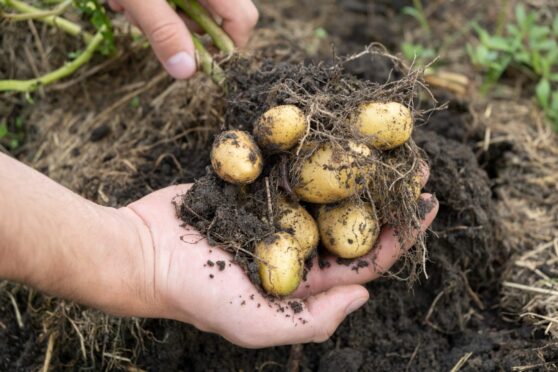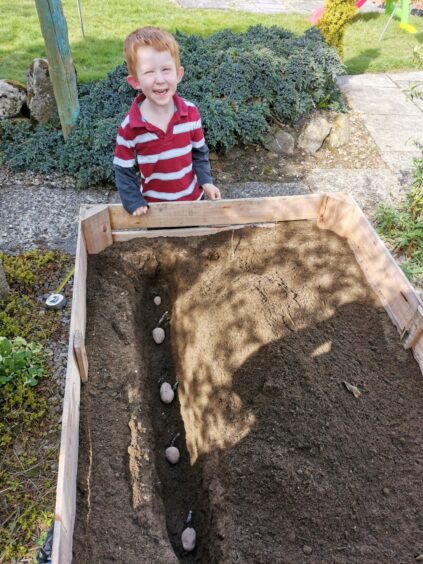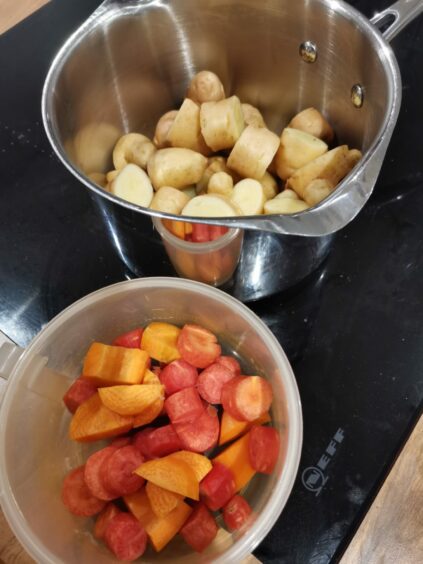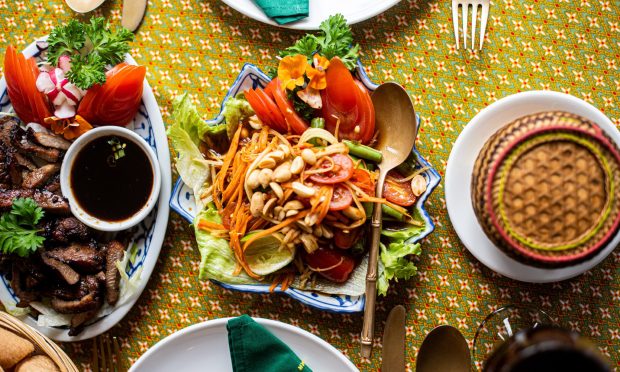Any foodie fans out there might remember last years Great British Menu Scottish heat winner, Adam Handling.
The theme of the year was celebrating 100 years of Great British broadcasting.
Adam graced the competition with his incredible starter, ‘Tattie Planting Time’.
The dish was his potato focused homage to BBC Scotland’s Beechgrove Garden.
He delivered a bed of Jerusalem artichoke puree with confit potatoes, crispy potato discs and cream cheese and chive-filled gnocchi.
Sparkling wine and caviar, a sauce of whey butter, topped with roast potato foam.
Displayed upon tattie sacks with and mini watering cans for the sauce.
Yum! I may not be able to provide that amazing sounding dish but as Head Gardener of Beechgrove Garden, I certainly can deliver the star ingredient!
Tattie observations
The tatties are always a main staple of the show, much as it’s a main staple of our diets and even culture.
Carole Baxter will be performing her observations of first early tatties in bags, which this year can be compared to the same cultivars in the ground.
It will be interesting to compare yields, especially as there are advantages to both methods.
Tattie bags have the edge in terms of faster soil temperatures due to the limited space and hence faster growth kick off.
The downside of course is they require more watering and potentially hold less potatoes when compared to the much larger available space of free ground.
Tattie bags are a fantastic way however, to grow your own if you are limited in garden space. Even those with only a balcony can grow their own lovely potatoes.
Main crops
As part of the celebrations for Beechgrove Garden’s 45th anniversary, we are hosting a sapphire theme.
The tatties are no exception so we will be observing some unique, blue, main crop cultivars this year.
The tatties have been chitting nicely in the Robinson glasshouse.
It is a cool, frost free place at night but during the day they get popped into a coldframe, to stop them turning into baked tatties!
It gets toasty in the glasshouse during the heat of the day.
Chitting is the practice of allowing potatoes to develop sprouts from the ‘eyes’ in the lead up to planting, to give them a head start.
Tatties are placed in trays or egg boxes with the side where most eyes are sprouting from placed facing upwards.
A cool, light, frost free place is needed for this.
Chitting is especially done for first and second early varieties.
As you’ll have guessed, first earlies are planted first and ready first.
A typical first early is ready around 12-14 weeks after planting.
Second earlies are planted around the same time as first earlies, perhaps slightly later depending on when you want your tatties and are ready around 13-15 weeks later.
Maincrop are planted last and are ready around 16-20 weeks after planting.
Home stash
At home in my own garden, I plant a couple of rows of my first earlies in the ground around the start of April.
Around two weeks later I plant a couple of rows of second earlies.
Around two weeks after that I plant around four rows of main crops.
I find for me this allows me a good crop of new tatties at the end of June then just as I’ve greedily got through them all, the second earlies are ready around the start off mid-July.
As my stash of second earlies comes to an end, I find the maincrops are about ready around of the end of August/ early September.
Maincrops store well and can last all winter when prepped properly.
This is why I grow four rows rather than just two. It’s great to be able to serve up your own home grown delicious tatties for Christmas and new year’s day dinner.
Prep for storage
First early and second early potatoes are ready when the majority of the shaws are in flower.
When lifted, these won’t store anywhere near as long maincrops and so you may as well tuck in and get them eaten.
To prep your maincrop tatties for long term storage, you allow the shaws to turn completely yellow and drooping then cut them off.
Wait around two weeks after this before lifting the tatties out the ground. Leave them out in the sun for a few hours so they can fully dry off and make sure all excess soil is brushed off before bringing them in.
They can then be stored in a cool, dry place.
I personally place them in small bakers trays I have and keep them in a drawer in the utility room.
Good old hessian sacks are often used many. These help to provide a nice dry, cool, dark, environment.














